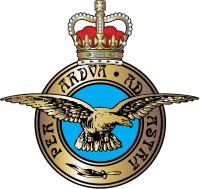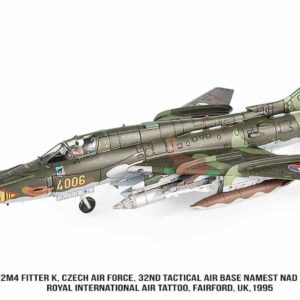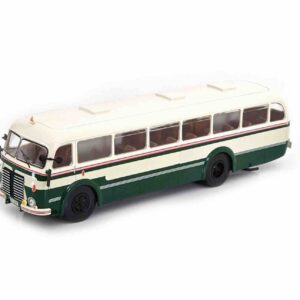Atlas Editions Bombers of WWII – De Havilland DH-98 Mosquito Mk.IV
499 Kč
Skladem
Výrobce: Atlas EditionsMěřítko: 1:144Popis
-sběratelský model letadla de Havilland Mosquito 1/144 -provedení: kovový model s plastovými částmi -model je v kvalitním provedení -součástí balení je stojánek
de Havilland DH.98 Mosquito
de Havilland DH.98 Mosquito byl britský víceúčelový bojový letoun, který od počátku svého nasazení roku 1941 představoval tvrdý oříšek pro stíhače Luftwaffe, kterým většinou unikal díky své vysoké rychlosti. Byl používán jako lehký bombardér, noční i denní stíhač a průzkumný letoun. Pro své kvality, které měl i přesto, že většina stroje byla tvořena dřevěnou konstrukcí, dostal přezdívku Dřevěný zázrak.
The de Havilland DH.98 Mosquito is a British twin-engine shoulder-winged multi-role combat aircraft. The crew of two, pilot and navigator, sat side by side. It served during and after the Second World War. It was one of few operational front-line aircraft of the era whose frame was constructed almost entirely of wood and was nicknamed The Wooden Wonder.
| Role | Light bomber Fighter-bomber Night fighter Maritime strike aircraft photo-reconnaissance aircraft |
|---|---|
| Manufacturer | de Havilland Aircraft Company |
| First flight | 25 November 1940 |
| Introduction | 15 November 1941 |
| Status | Retired |
| Primary users | Royal Air Force Royal Canadian Air Force Royal Australian Air Force United States Army Air Forces |
| Produced | 1940–1950 |
| Number built | 7,781 |
De Havilland Mosquito FB.( Fighter-Bomber variants.)
The FB Mk VI, which first flew on 1 June 1942, was powered by two, single-stage two-speed, 1,460 hp (1,090 kW) Merlin 21s or 1,635 hp (1,219 kW) Merlin 25s, and introduced a re-stressed and reinforced “basic” wing structure capable of carrying single 250-or-500-pound (110 or 230 kg) bombs on racks housed in streamlined fairings under each wing, or up to eight RP-3 25lb or 60 lb rockets. In addition fuel lines were added to the wings to enable single 50 imp gal (230 l) or 100 imp gal (450 l) drop tanks to be carried under each wing.The usual fixed armament was four 20 mm Hispano Mk.II cannon and four .303 (7.7 mm) Browning machine guns, while two 250-or-500-pound (110 or 230 kg) bombs could be carried in the bomb bay.
General characteristics
- Crew: 2: pilot, navigator/radar operator
- Length: 41 ft 2 in (12.55 m)
- Wingspan: 54 ft 2 in (16.52 m)
- Height: 17 ft 5 in (5.3 m)
- Wing area: 454 ft2 (42.18 m2)
- Empty weight: 13,356 lb (6,058 kg)
- Loaded weight: 17,700 lb (8,028 kg)
- Max. takeoff weight: 18,649 lb (8,549 kg)
- Powerplant: 2 × Rolls-Royce Merlin 21/21 or 23/23 (left/right) liquid-cooled V12 engine, 1,480 hp (21 & 23) (1,103 kW) each
| No. 105 Squadron RAF | |
|---|---|

No. 105 Squadron badge
|
|
| Active | 23 Sep 1917 – 1 Feb 1920 12 Apr 1937 – 1 Feb 1946 21 Feb 1962 – 20 Jan 1968 |
| Country | |
| Branch | |
| Nickname(s) | “Hereford’s own Squadron” |
| Motto(s) | Latin: Fortis in Proeliis (“Valiant in battles”) |
| Commanders | |
| Notable commanders |
|
| Insignia | |
| Squadron Codes | MT (Oct 1938) GB (Sep 1939 – Jan 1946 ) |
The Royal Air Force (RAF) is the United Kingdom’s aerial warfare force. Formed towards the end of the First World War on 1 April 1918,it is the oldest independent air force in the world. Following victory over the Central Powers in 1918 the RAF emerged as, at the time, the largest air force in the world. Since its formation, the RAF has taken a significant role in British military history. In particular, it played a large part in the Second World War where it fought its most famous campaign, the Battle of Britain.
| Royal Air Force | |
|---|---|

Badge of the Royal Air Force
|
|
| Founded | 1 April 1918 |
| Country | United Kingdom |
| Type | Air force |
| Role | Aerial warfare |
| Size | 33,840 active personnel 832 operational aircraft 1,940 RAuxAF 2,220 reserve personnel |
| Part of | British Armed Forces |
| Air Staff Offices | Whitehall, London |
| Motto(s) | Latin: Per Ardua ad Astra “Through Adversity to the Stars” |
| March | Royal Air Force March Past |
| Commanders | |
| Chief of the Air Staff | Air Chief Marshal Mike Wigston |
| Notable commanders |
Lord Trenchard Lord Portal |
| Insignia | |
| Ensign |
 |
| Logo |
 |
| Roundels |   |
| Fin flashes |   |
| Pilot’s brevet |  |
| Aircraft flown | |
| Attack | |
| Fighter | |
| Trainer helicopter | |
| Utility helicopter | |
| Reconnaissance |
|
| Trainer |
|
| Transport |
|
Další informace
| Výrobce | |
|---|---|
| Měřítko | |
| Dostupnost | Skladem |







